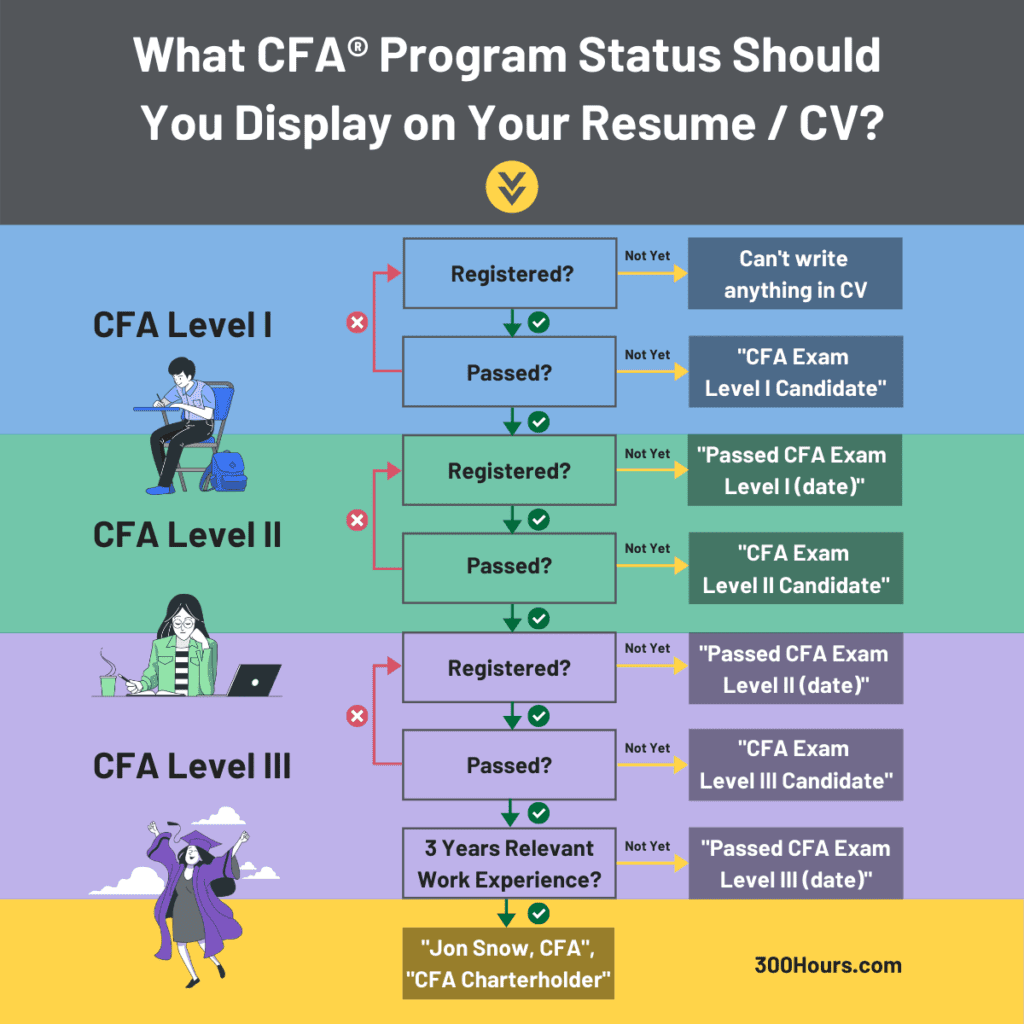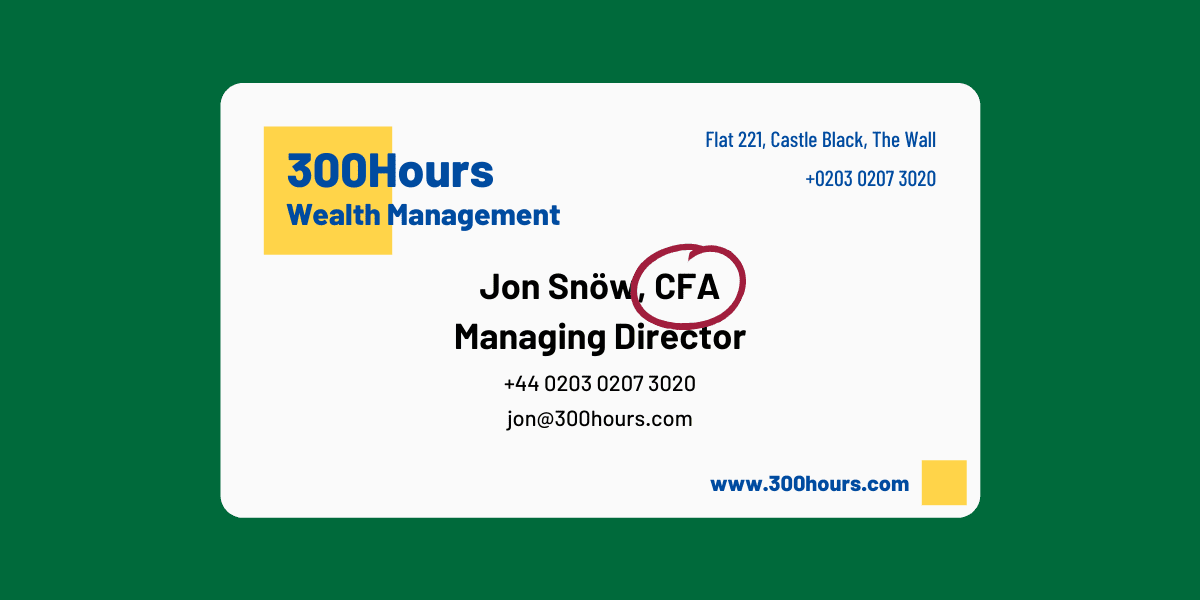With 45% of candidates registering for CFA exams for career reasons, it is crucial to keep your “personal marketing materials” – such as CV/resume, LinkedIn, business cards and even email signature – up-to-date to reflect your latest accomplishments in the CFA Program.
However, did you know about CFA Institute’s strict guidelines on the CFA designation usage on any written communication? Without knowing it, many candidates and charterholders are in violation of these by-laws and could be sanctioned by CFA Institute. And we thought putting CFA on resume was the easy part…
If you’re looking to spruce up your resume especially after results day, we’ve got you covered: here’s our comprehensive guide on how to add CFA to LinkedIn, resume or business cards correctly as per CFA Institute guidelines.
Go through this extensive guide chronologically to ensure you don’t miss anything out!
Let’s get going:
What are CFA digital badges? How do I use them?
First off, a relatively recent development: CFA Institute currently distributes digital badges to relevant candidates and charterholders as a means to showcase their achievements in an online, verifiable format.
There are essentially 3 badges available for:
- candidates who passed Level I;
- candidates who passed Level II;
- CFA charterholders.

Yes folks. This is an image. Of some badges. That you put on LinkedIn or other social media sites.
Anyways, why isn’t there a “Passed Level III” badge, I hear you ask?
Here’s CFA Institute’s rationale:
“CFA Institute is pleased to offer digital badges for candidates that have successfully completed Level I and Level II, as well as individual’s that have earned the CFA charter. In order to avoid confusion in the market and ensure we are not degrading the value of the charter, we will not be offering badges to candidates that have passed Level III. Once the individual has earned the relevant work experience and become a member, they will receive the charterholder digital badge.”
How to claim your CFA digital badge
For recent candidates/charterholders who qualify for these badges, Basno (a digital badge vendor) would send you an email on behalf of CFA Institute a few weeks post results day. To claim your badge:
- just click “Claim Your Badge” within that email, and
- sign up with Basno.
For “older” candidates/charterholders who qualified for these badges years ago, here’s how to claim them:
- click on the relevant badge on Basno’s website (passed Level I, passed Level II, or CFA charterholder),
- click on “Get this badge”,
- enter your email address,
- then click “Continue” for an instant verification.
How to correctly show CFA on resume?
Here is the definitive guide to what should go on your resume for all phases of your CFA qualification process.
The following diagram summarizes everything you’ll need to know to do this correctly.

To indicate your CFA qualification status on your resume/CV:
- put “CFA Institute” as an educational awarding body in the “Education” or “Professional Development” section, and
- list your current status as your most recent qualification. For example (choose level as appropriate):
- CFA Exam Level I / II / III candidate;
- Passed CFA Exam Level I / II / III (date); or
- CFA Charterholder (date)
- Finally, only for those who have been awarded the CFA charter, you can show that you’re a CFA charterholder on resume by placing the marks “CFA” or “Chartered Financial Analyst” after your name in the header of your CV/resume. For example:
- Jon Snow, CFA
- Jon Snow, Chartered Financial Analyst
The exact wording of your status will depend on where you are in the program. As shown above, at each stage of your CFA Program qualification process, you have to clearly state whether you are a candidate, or you have passed. You can only state that you are a candidate if you have registered for the exam, i.e. passing Level I does not automatically grant you “Level II candidate” status.
Remember that charterholders can only use the trademarks “CFA” or “Chartered Financial Analyst” if:
- they are fee-paying members of CFA Institute (annual membership dues of USD 275);
- they are not subject to certain Professional Conduct violations; and
- their rights to use the CFA designation have not been suspended or revoked.
Note that we won’t be covering finer points such as what should you EXACTLY write on your CV come charterholder status, (e.g. not using the phrase “Jon is a CFA” and all the rest).
I’m going to assume you already know this from your Ethics studies (if not, you may need to brush up on this). Else, happy to elaborate on this in a future post, just let me know in the comments below or the Forum.

Can I use “CFA Charter pending” if I’m just waiting for work experience?
No, you can’t.
The point to keep in mind is that you cannot state, or even vague imply that you are a CFA charterholder, until you are actually one.
There are many CVs and LinkedIn profiles that will state otherwise – a repeat offender is “CFA Charter Pending”, “CFA, Expected 20XX” or something similar. This is a violation of Standard VII(B) of CFA Institute Ethics and Professional Standards, and you could be sanctioned by CFA Institute for that.
If you have passed all 3 exams and are just waiting for work experience, I do agree with you that passing the exams is the hardest part, but you still can’t imply charterholder status, or caveat it with some sort of “pending” disclaimer.
You are, however, allowed to state on your CV “Passed all three levels of the CFA Program [date optional], and may be awarded the charter upon completion of the required work experience.“
Should I put in a date of when I passed, or when I expect to obtain my CFA charter?
The key thing to bear in mind is this: you can only state facts, not projections. If you wish to state the dates of when you passed your exams, that’s absolutely fine.
What you cannot do is to post a date where you ‘expect’ to pass a certain level or obtain your charter. Dates in the past are fine, dates in the future are not allowed.
Should I put in the fact that I passed all 3 levels consecutively?
If you passed each level of the exam in consecutive years and wanted to mention it in your CV / resume, that is not a violation of Standard VII(B) because it is a statement of fact.
For example, these statements would be acceptable:
- “I passed all three CFA exams consecutively on the first attempt”, or
- “I passed all three CFA exams in three consecutive years”.
If however, you went ahead to claim or imply superior ability by obtaining the designation in only three years, this would be a violation of Standard VII(B).
As to whether you should put this fact in your CV / resume, it is really a personal choice. Some may think that it may help job search, but others think it may appear arrogant.
Does it matter? Can’t I just write what I want?
Well, it won’t be the best idea to blatantly flout the guidelines.
CFA Institute owns the trademark to the ‘CFA’ designation, so technically they could pursue you for misuse of trademark.
From our experience, they can be pretty vigilant in spotting violations and they are quite strict on following up on them, so we strongly recommend that you follow the guidelines.
How to add CFA to LinkedIn

What about LinkedIn, an increasingly important careers channel?
Before we start, note that the “Experience” section of a LinkedIn profile is intended to display your employment experience. Therefore, listing your CFA Institute membership or candidacy in this section can create the impression that you are an employee of CFA Institute, which could be considered a violation of the Code of Ethics and Standards of Professional Conduct.
Fortunately, LinkedIn profiles have sections labeled “Licenses & Certifications” and “Test Scores”, which is the most appropriate place to indicate your CFA license, depending whether you’re a charterholder or a candidate.
Here’s how to update your LinkedIn profile correctly, as per CFA Institute guidelines:
CFA Charterholders: 3 Ways to Update Your LinkedIn CFA Title

1) Add “, CFA” after your last name
- Just a simple, but necessary profile edit 🙂
- In my view, this is the most effective branding on LinkedIn for CFA charterholders.
2) Add a certification under “Licenses & Certifications” section
- In your LinkedIn profile, select “Add Profile Section” (a blue button near your profile photo).
- Under Background, select “Licenses & Certifications”. Fill in the form as follows then select “Save”.
| Name | If your charter has been awarded, enter “Chartered Financial Analyst (CFA) Charterholder.” |
| Issuing Organization | CFA Institute |
| Box labeled “This credential does not expire” | CFA Institute members may check this box as long as you satisfy the requirements to maintain your status. In the event that you allow your membership to lapse, you must select the month and year that your membership lapsed. |
| Issue Date | Select the month and year in which you received your charter. |
| Credential ID | Leave this field blank. |
| Credential URL | You may insert your digital badge URL. |
3) [Optional] Add your CFA charterholder digital badge in the About section
- Select “Add Profile section”
- Select “About”
- Under “Media”, select “Link”
- Paste your digital badge URL and select “Add”, then “Apply”
- Select Save
CFA Candidates: 3 Steps to Update Your LinkedIn CFA Status
In general, a CFA Program candidate can indicate which level they have passed under the “Test Scores” section, and/or state that they are a candidate in the program under “Courses” section.
Please remember that it is against the CFA Institute guidelines to:
- use your candidacy in the Heading of your profile, and/or
- indicate an “Expected” date.
Here’s how to do these LinkedIn profile updates correctly:
1) Indicate that you have Passed CFA Exam Level I / II / III under “Test Scores” section
- In your LinkedIn profile, select “Add Profile Section”.
- Under Accomplishments, select “Test Scores”. Fill the form as follows and then click “Save”.
| Test Name | Enter the appropriate level: “CFA Exam Level I / II / III”. |
| Associated With | Leave this field blank. |
| Score | Enter “Passed” if you would like to indicate the level you have passed. |
| Date | Enter the month and year of the date you passed the exam. |
| Description | Enter the level you have completed, e.g., “Passed Level I of the CFA Program”. If you have completed all 3 levels of the CFA Program, but have not completed the work experience requirement, you may state: “Passed all three levels of the CFA Program and may be awarded the charter upon completion of the required work experience.” |
2) [Optional] Indicate your candidacy under “Courses” section
- Under Accomplishments, select “Courses”.
- Under Course Name, enter the appropriate level “CFA Exam Level I / II / III Candidate”. Leave all other fields blank.
3) [Optional] Add your CFA candidate digital badge in the “About” section
- Select “Add Profile section”
- Select “About”
- Under “Media”, select “Link”
- Paste your digital badge URL and select “Add”, then “Apply”
- Select Save.
How to display your CFA Charterholder status on business cards & email signatures

You are probably aware of CFA Institute’s official trademark guidelines on the proper use of CFA and Chartered Financial Analyst marks.
But here’s our keep-it-simple recommendation that incorporates those guidelines with a touch of real-world practicality:
- For email signatures: adding “, CFA” behind your last name is sufficient.
- For business cards:
- adding “, CFA” behind your last name, or
- “Chartered Financial Analyst” in the next line (after your first and last name)

Yup, that’s it.
But a few things to note:
- It is not necessary to use the ® symbol when the marks directly follow the name of a specific individual.
- According to Standard VII(B) of the Standard of Practice Handbook, the CFA designation should not be given more prominence (e.g., larger or bold font) than the charterholder’s name.
- Whilst adding “, Chartered Financial Analyst” is allowed by CFA Institute guidelines, we have omitted that in our recommendation for business cards as it may be too long and perhaps obstructive in the business card design.
What about candidates, we hear you ask?
While it is certainly permissible to state the fact that you have passed a certain level, the practice of putting levels passed on business cards is non-standard and may come across as slightly desperate (although it’s fine for CV/Resume and LinkedIn).
For candidates, it is probably best to work hard and obtain your charter before putting anything on your business card and email signature.
Got a question or an example that is confusing you? We’d be happy to help you out – just leave a comment below!
Meanwhile, here are a few related articles that may be of interest:
- When will my CFA results be released?
- Is TopResume worth It? I paid for one, here’s my thoughts
- How to write a good resume: 11 actionable tips
- How to prepare for an interview: 3 steps to secure your job offer
- How to network: 7 easy networking tips to boost your career
- Finance career change planner: use our free tool to switch finance jobs

Good day,
I have passed all 3 levels of the CFA program, and will earn my charter on completion of the required work experience.
My concern however, is with regard to publishing my CFA 1 and CFA 2 digital badges.
In the “add About” section there is no media window in which to add the link and/or the digital badge.
Please advise.
Is there any rule about if CFA needs to be in a smaller font or same font as name on a business card?
Hi Darlene, yes CFA Institute has specifications on that. You can use a smaller front size for “CFA” designation than your name, if preferred. That said, the CFA designation should be the same font size and boldness as other designations that may be listed.
So to answer your question, the CFA designation can be either in a smaller font, or same size as your name on a business card. Not larger.
So to be clear,
I could not put CFA Level II Candidate in my profile?
Hi Collin, if you check the infographic summary, you can put CFA Level II candidate in your profile if you have passed Level 1 AND registered for Level 2.
Hi, are we allowed to add our status as a CFA Level I Candidate in the “Licenses and Certifications” section on LinkedIn, what about after we passed CFA L1, and what about after we passed all levels?
Also, is my understanding correct that if we are a Level I candidate, only step 3 applies to us (since one needs to pass L1 to get a badge) and step 1 is only for those who have at least passed L1?
what about a person who earned the Regular Membership with work experience but did not sit for any cfa programs, Do they receive any membership certificate or not ?
Unfortunately not Dave. There is nothing you can show about your CFA Program progression until you passed CFA Level 1.
Hi,
is it proper to state in an email signature the following?:
[name]
Asset Manager, CFA
Best regards
Lena
Hi Lena, it’s probably just [Name], CFA. 🙂
Hi all. I have recently become a CFA Institute Member following 3 years of experience and passed Level 1. Can I use this on my LinkedIn profile?
Hello, i completed cfa level 3 and I’m waiting on my charterholder application, my company provided the following discription on my profile, she holds several qualifications, including CFA level 3, is this a correct way of framing it?
Thank you
Yes if you have passed CFA Level 3 but not a charterholder yet (as you’re applying for it), that would be correct.
Must i put the CFA designation after my full name or can i just put the CFA designation after my First & Last name?
Eg.
First name: John
Middle name: Teck Soon
Last name: Lim
So, must this be John Teck Soon Lim, CFA or
John Lim, CFA is sufficient?
John Lim, CFA is perfect as is 🙂 Congratulations!
Are people allowed to share on social media (linkedin) their chart with score results? Guessing not but could not find a direct statement on it.
My interpretation of the rules, Ethics and Standards etc on this is that it’s your right to share this information, but not to then imply that this makes you better than anyone else in e.g. investment of job performance.
This is just my interpretation though. When in doubt, don’t do it.
I have finished my CFA Level 3 Exam and I am waiting for the result.
Can I say “I am working towards the CFA Certification and have passed CFA Level II Exam?”
Yes, I think that should work.
Cleared L1 with 90+ percentile.
Can I add this detail on my resume? If so what would be the correct format?
Hi UHK, you can put factual things in your resume. However, personally I do not think it will reflect well if I am a hiring manager.
I haven’t seen any guidance about the appropriateness of noting on your CV which session of the exam you are registered for. (ie: CFA Level I Candidate (December 2019)). Does anyone know about this? Technically it is not saying passing is expected, it is just stating the fact of which session you are sitting for…
Just got a resume that says “Passed all three exams in 4-5 hours (6 hours are allotted).” I guess it’s technically a fact (if it is true). It seems pretty clearly implied that fewer hours is superior to more hours, though I’ve always thought mentioning 3 for 3 on exam attempts was implying something also. Thoughts ? Violation or not ?
I don’t think that is verifiable and I’d definitely advise against it. Depending on when you wrote and which exam centre you can not leave in the last hour anyway. The new thing to brag about and it is verifiable if you save the email is whether you were in the top 10% in the world for that particular exam. That should be rare but I know people will be claiming this but they can not claim they will automatically generate superior returns.
Your point about the top 10% is interesting! We should see that pop up in resumes soon, if not already…
I don’t think it’s technically a violation, but I’m not sure what does that tell me about the job applicant – that they value speed over thoroughness? I’d rather hire an employee that uses the allocated time to ensure they do a good job, rather than save 15-30% of the time to do…what? 3 for 3 on the other hand indicates something slightly different, although I agree that it may not necessarily indicate anything tangible to a prospective employer.
I am going from memory here, but I believe that if something is not verifiable (i.e. completed the exam in 4-5 hours), it is an ethics violation to include it.
Oh I see. I misunderstood ‘biweekly’ (doh) – I currently update twice a week, every Monday and Thursday.
Haha wow I definitely didn’t know part 2 of this definition. This makes more sense now! biweekly 1.Occurring once every two weeks. 2.(chiefly UK) Occurring twice a week
Haha. No no, entirely me being idiotic. That’ll teach me to stay up late and be sleep deprived.
I should update more often than biweekly, but you suggest once a week? Which is which?
I suggest one update per week but realize this may be unpractical as there is only so much one can say about the CFA. For this reason, a biweekly update [once every 2 weeks] is understandable. Sorry if I was unclear before.
You can definitely state that you passed 3/3, but you’re not allowed to imply that you’re therefore a better analyst / investment manager (as you’d know from Ethics). Thanks for the feedback! Bi-weekly is what I can commit to with my work schedule at the moment – if readership and demand increases I can look at adjusting. What do you think would be an ideal update frequency?
This site kind of reminds me of http://www.mergersandinquisitions.com – but it’s almost apples and oranges because of the subject matter. Once a week would be fun but I’m not sure there is enough content to merit that. Anything is better than trolling Analyst Forum though!
Is there any utility in mentioning you passed 3/3? And if so, is it against the Code & Standards to mention that on a resume? Awesome post btw. You should update more often than biweekly.
If it is a fact you can state it. It probably helps with some employers/clients as a lot of us fail. 😉 In practice I think most often the charter gets abbreviated down to an acronym after a name. Depends how long you want your bio/CV to be.
It’s fine to state that you passed all three on the first try, but you can’t imply that it makes you a better analyst.
Just added it – thanks for the heads up!
You left out the warning about anticipated completion date. I don’t have it in the education section on my resume or even my LinkedIn profile as those formats want a date. You’re not allowed to put an anticipated graduation data, like many people do with their university programs.